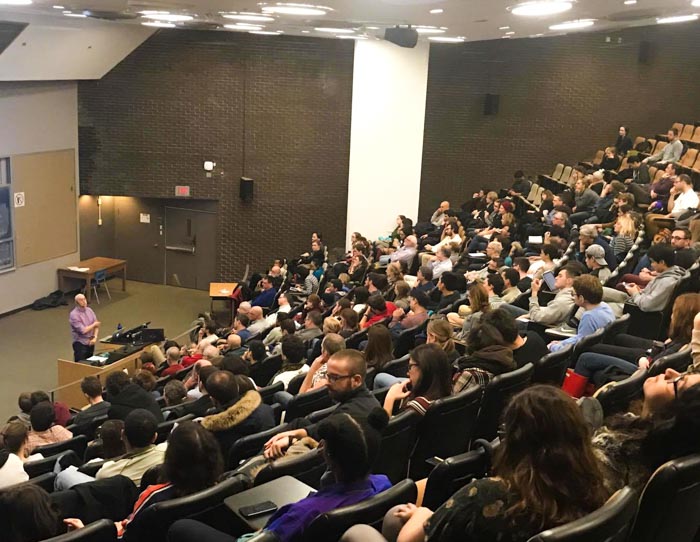The universe is comprised of billions of galaxies—encompassing all of space, all of time, and all of its contents. It all started with a Big Bang 13.8 billion years ago.
On Nov. 16, particle physicist and cosmologist Oscar Hernández spoke about the Big Bang at AstroMcGill’s event Where, When & Will It Ever End: a Muggle’s Guide to Our Big Bang, at McGill’s McIntyre Medical Building.
Hernández pointed out a common misconception: The Big Bang was not actually an explosion. It was, in fact, an expansion. According to Hernández, a better name for the theory would be the “Everywhere Stretch Theory.”
Like most discoveries, this one cannot be localized or attributed to one person. In 1842, Christian Doppler proposed the Doppler Effect for light—that the colour of a star’s light changes according to its velocity. Redshift indicates that an object is moving away from the viewer, while blueshift indicates that it is moving closer. Furthermore, in 1912, Vesto Slipher first observed galaxy light and saw that it was redshifted.
Other scientists contributed to the theoretical understanding of expansion. Albert Einstein published his general relativity field equations in 1915, which he was able to use to derive a history of the universe—despite its inaccuracy.
“Einstein got a solution to his equation but […] he forced that solution to be static,” Hernández said. “Spacetime tells energy and matter how to move, and energy and matter tell spacetime how to curve, and Einstein comes up with his static universe solution that’s not stable.”
Edwin Hubble was given the credit for the discovery of the cosmos. In 1923, Hubble showed that “clouds” that were previously thought to be nebulae were actually other galaxies that were millions of light years away. He then studied the velocities of these galaxies, and in 1929, concluded that they were receding from Earth, and thus that the universe was expanding.
In 1927, Georges Lemaître proposed the Big Bang Theory—which he called the “hypothesis of the primeval atom”—using Einstein’s equations and theories of general relativity. Building upon earlier observations, he said that if the universe was expanding, the galaxies’ light should be redshifted.
Lemaître proposed and Hubble calculated that space was literally expanding and growing between the galaxies. Hernández equated galaxies to raisins in a rising loaf of bread—they’re not moving apart, but rather space is getting bigger.
“The laws of physics are time-symmetric […] so we can run this movie backwards 14 billion years to get this very dense, very hot, very well-ordered, very small cosmic egg of pure energy,” Hernández said.
This relation directly connects the astronomically big to the infinitesimally small. In other words, to study the beginning moments of something as big as the universe, the extremely tiny must also be analyzed.
“[For the first 380,000 years of cosmic time], when the temperature was above 3000 Kelvin, […] light electrons and protons were in a cosmic soup. They were not bound together,” Hernández said.
But as the universe aged and expanded, it cooled. The protons and electrons had less energy to resist one another, thus combining to form hydrogen: The most common element in the universe.
“With fewer free electrons for light to interact with, the universe became transparent,” Hernández said. “When we finally see the light here on Earth, [it] has been stretched so much by the 14 billion-year expansion of space that its frequency and colour have shifted from the original semi-white all the way to cool microwaves.”
This radiation, called the cosmic microwave background, is the heat left over from the Big Bang. Astrophysicists have even been able to map its afterglow.
So, to answer where, when, and will it ever end—the Big Bang occurred everywhere almost 14 billion years ago, and the expansion is not going to end. In fact, scientists have discovered that it is accelerating over time.
There’s still much to learn about the beginning of our universe. By fully understanding its expansion, the mysteries of its origin can be unravelled.






